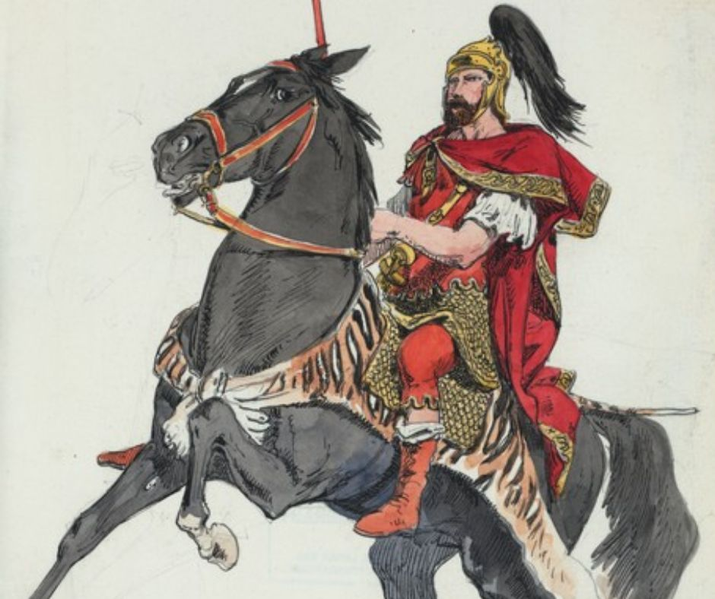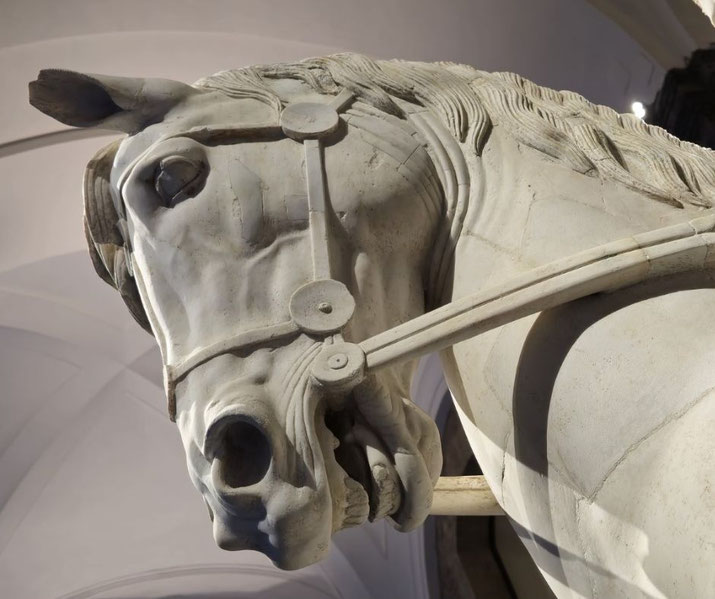How did the ancient Romans use cavalry in battle?

Beneath the radiant Mediterranean sun, on the vast fields that would define the borders of an empire, the thunderous charge of Rome's cavalry often tipped the scales of ancient warfare.
These horse-mounted warriors, frequently overshadowed by the fame of the Roman legions, played a critical yet often underappreciated role in Rome's ascent to power.
From the early days of the Roman Republic to the sprawling reaches of the Roman Empire, the cavalry served as an instrumental force, both on and off the battlefield.
But who were these horsemen, these thundering agents of Rome's imperial will?
What role did they play in the legendary battles that shaped antiquity?
Origins of Roman Cavalry
The origins of the Roman cavalry, or equites as they were known in Latin, can be traced back to the early days of the Roman Republic, around the 6th to 5th century BC.
At this time, Rome was just one of many city-states on the Italian peninsula, with its military structure heavily influenced by its neighbors, notably the Etruscans to the north and the Greeks to the south.
The early Roman cavalry was primarily made up of the Roman aristocracy, the patricians.
These were individuals who could afford to maintain a horse for military service.
This practice was common among many ancient societies, where the warrior elite typically fought as heavy cavalry.
Each Roman cavalryman provided his own horse, armor, and weapons, a fact that further underscored the socio-economic status of these early horsemen.
The horse, in particular, was a significant investment, as it required not just the initial cost of the animal, but also the ongoing expenses of stabling, feeding, and training.

Structure and development of Roman cavalry
The structure and composition of the Roman cavalry evolved significantly over the course of the Republic and the Empire, reflecting Rome's expanding horizons and changing military needs.
Early Republic (509-264 BC):
Initially, during the early Republic, the Romans placed more emphasis on their infantry forces and viewed cavalry as a supporting element.
However, as Rome expanded its territories and encountered different enemies, the importance of cavalry increased, and it became an integral part of Roman military doctrine.
In this early period, the cavalrymen, known as equites, were organized into units of 30 men called turmae, each led by a decurion.
Each Roman legion, an army unit of approximately 5,000 men, would typically include 300 cavalrymen, divided into ten turmae.
Middle Republic (264-133 BC):
During the middle Republic, following the First Punic War and Rome's initial forays into overseas empire, the Roman cavalry began to diversify.
As Rome's wealth increased, so did the number of equites, which now included wealthy plebeians as well as patricians.
Furthermore, Rome began to rely more on allied and auxiliary cavalry, including renowned horsemen from places like Thessaly in Greece, Numidia in North Africa, and Hispania (modern Spain).
During the middle Republic, the Roman military doctrine emphasized a combined arms approach, with infantry, cavalry, and light troops working together to achieve victory.
The cavalry's role expanded beyond reconnaissance and flanking to include shock charges, pursuit, and harassment of enemy forces.
The Romans recognized the mobility and versatility of cavalry, utilizing it to disrupt enemy formations and exploit opportunities on the battlefield.
Late Republic and Early Empire (133 BC-180 AD):
By the late Republic and the early Empire, Rome's cavalry was increasingly made up of auxiliaries - non-citizen troops from the provinces.
These auxiliaries brought a wide range of cavalry types to the Roman army, including light skirmishers, heavily armored cataphracts, and horse archers.
The late Republic and early Empire also saw further developments in Roman military doctrine.
The Marian reforms of the late Republic, which transformed the Roman legions, also had an impact on cavalry tactics.
The legions became more standardized, allowing for better coordination between infantry and cavalry.
Cavalry played a crucial role in supporting infantry maneuvers, protecting the flanks, and engaging in decisive charges when necessary.
They became an integral part of the combined arms approach and were often deployed in larger numbers, reflecting their increased significance in Roman warfare.
Late Empire (180-476 AD):
In the late Empire, the Roman cavalry underwent significant changes. Influenced by confrontations with the Parthians, Huns, and other horse-based armies, the Romans began to place more emphasis on cavalry.
This was a shift from the infantry-focused armies of the Republic and early Empire. Heavy cavalry, including clibanarii and cataphracts, became more common, and there was a greater focus on combined arms tactics, with infantry, cavalry, and archers working closely together.
How were the cavalry equipped?
In terms of equipment, Roman cavalrymen were typically armed with a long spear (hasta) or a short thrusting spear (lancea), a sword for close combat, and sometimes a bow for skirmishing.
They wore a variety of armor types, ranging from chainmail to scale armor to laminar armor, and carried oval or round shields.
Their horses, while smaller by modern standards, were sturdy and well-trained, capable of carrying a heavily armed and armored rider into battle.

Tactical Role of Cavalry in Battle
The tactical role of the Roman cavalry in battle evolved significantly over time, but throughout the history of the Roman Republic and Empire, the cavalry was an integral part of the Roman army's tactical toolbox.
Scouting and Reconnaissance:
One of the primary responsibilities of the Roman cavalry was to act as the eyes and ears of the Roman army.
Cavalry units, due to their mobility, were ideal for scouting enemy positions, tracking enemy movements, and gathering intelligence.
They would often ride ahead of the main Roman force, providing critical information to the Roman commanders about the terrain, the location of enemy forces, and other strategic considerations.
Flanking and Encirclement:
On the battlefield, one of the key tactical uses of the cavalry was to outmaneuver enemy infantry by using their superior speed and mobility.
The Roman cavalry would often attempt to flank the enemy, attacking from the sides or rear to sow confusion and panic.
In some cases, they might even attempt to encircle the enemy, trapping them in a deadly pincer movement with the Roman infantry.
Pursuit and Harassment:
If an enemy force attempted to retreat or break formation, the Roman cavalry was there to take advantage.
They were often tasked with pursuing fleeing enemies, preventing their reorganization and capturing or killing as many as possible to prevent future threats.
Similarly, during an enemy advance, the Roman cavalry might be used to harass and disrupt their formations, throwing them into disarray before the main clash with the Roman infantry.
Defense and Rearguard Action:
While the Roman infantry was typically responsible for holding the line in a Roman battle, the cavalry also had defensive roles.
They could be used to protect the flanks of the Roman infantry from enemy cavalry, or to serve as a rearguard during a Roman retreat, slowing down pursuing enemies and providing cover for the rest of the Roman force.
Flexible Response:
Perhaps most importantly, the Roman cavalry provided a flexible, fast-moving reserve that could respond quickly to changing circumstances on the battlefield.
Whether this meant reinforcing a struggling infantry unit, exploiting a weakness in the enemy line, or responding to an unexpected threat, the Roman cavalry was a versatile force multiplier that added a dynamic element to Roman battle tactics.
Famous Roman Cavalry Engagements
Battle of Cannae (216 BC):
The Battle of Cannae was one of the most devastating defeats in Roman history, with the Carthaginian general Hannibal famously encircling and destroying a much larger Roman army.
However, it also demonstrated the potential of cavalry. Hannibal's Numidian and Gallic cavalry played a crucial role in the battle, first defeating the Roman cavalry and then attacking the Roman infantry from the rear, contributing to the encirclement.
Battle of Zama (202 BC):
The Battle of Zama was the decisive battle of the Second Punic War, where Roman general Scipio Africanus defeated Hannibal.
Roman and Numidian cavalry played a key role in the victory. Scipio used the superior Roman infantry to hold the line against Hannibal's infantry and elephants, while the Roman and Numidian cavalry, led by Masinissa, defeated Hannibal's cavalry and then attacked the Carthaginian infantry from the rear, mirroring Hannibal's tactics at Cannae.
Battle of Carrhae (53 BC):
This was a catastrophic defeat for the Romans against the Parthians, demonstrating the superiority of Parthian horse archers and cataphracts over the Roman heavy infantry.
The Roman cavalry was completely outmatched by the Parthian horsemen, who used their mobility and range to devastating effect.
Battle of Adrianople (378 AD):
In this battle, during the late Roman Empire, the Eastern Roman Emperor Valens was defeated by the Goths, largely due to the superior Gothic cavalry.
This battle highlighted the vulnerability of Roman infantry to heavy cavalry charges, which would become a staple of medieval warfare.

Decline of traditional cavalry warfare
As the Roman Empire faced new threats, particularly from Germanic tribes and the Huns, the traditional role of cavalry began to change.
The Roman cavalry faced challenges in countering the tactics of these mounted warrior cultures, who excelled in horse archery and shock charges.
The increased reliance on infantry-based defensive strategies, coupled with the difficulties in effectively countering new cavalry tactics, diminished the impact and relevance of Roman cavalry on the battlefield.
The declining economic strength of the late Roman Empire affected the ability to maintain a robust and well-equipped cavalry.
The cost of maintaining cavalry units, including the upkeep of horses and the provision of suitable equipment, became increasingly burdensome.
Financial constraints and resource scarcity led to a reduction in the size and quality of cavalry forces.
The Roman military increasingly focused on static defensive strategies, fortified borders, and the employment of large infantry forces.
This shift in emphasis marginalized the role of cavalry, which was historically more suited for rapid mobility and offensive actions.
The defensive nature of Roman military operations limited the need for large cavalry forces and decreased their overall significance.
The reforms introduced by Emperor Diocletian and later Emperor Constantine the Great fundamentally transformed the structure of the Roman military.
These reforms led to the creation of the limitanei and comitatenses, new infantry-focused units that had different priorities and strategic considerations.
While cavalry still existed within these formations, it had a diminished role compared to its previous prominence.
Influence on the medieval period
Roman cavalry tactics and organization heavily influenced the development of cavalry in medieval Europe.
The concept of heavy cavalry charges, shock tactics, and the use of disciplined formations owe much to Roman cavalry practices.
The mounted knights of the Middle Ages drew inspiration from the Roman cavalry's effectiveness on the battlefield.
The historical memory of the Roman cavalry became an iconic symbol of military power and prestige.
The image of a Roman cavalryman, with his distinctive armor, lance, and horse, resonated in Roman culture and beyond.
What do you need help with?
Download ready-to-use digital learning resources
Copyright © History Skills 2014-2025.
Contact via email
With the exception of links to external sites, some historical sources and extracts from specific publications, all content on this website is copyrighted by History Skills. This content may not be copied, republished or redistributed without written permission from the website creator. Please use the Contact page to obtain relevant permission.





